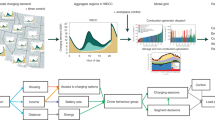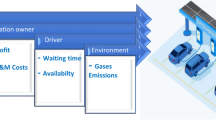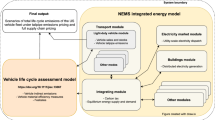Abstract
Full battery electric vehicles (BEVs) have become an important policy option to mitigate climate change, but there are major uncertainties in the scale and timing of market diffusion. Although there has been substantial work showing the potential energy and climate benefits of BEVs, demand-side factors, such as consumer behaviour, are less recognized in the debate. We show the importance of assessing BEV diffusion from an integrated perspective, focusing on key interactions between technology and behaviour across different scales, including power-system demand, charging infrastructure, vehicle performance, driving patterns and individual adoption behaviour.
This is a preview of subscription content, access via your institution
Access options
Subscribe to this journal
Receive 12 print issues and online access
$209.00 per year
only $17.42 per issue
Buy this article
- Purchase on Springer Link
- Instant access to full article PDF
Prices may be subject to local taxes which are calculated during checkout



Similar content being viewed by others
References
International Energy Agency World Energy Outlook (IEA, 2010).
International Energy Agency Energy Technology Perspectives (IEA, 2008).
World Business Council for Sustainable Development Mobility 2030: Meeting the Challenges to Sustainability (WBCSD, 2004).
World Energy Council Transport Technologies and Policy Scenarios to 2050 (WEC, 2007).
J. Rosenfeld . et al. Averting the Next Energy Crisis: The Demand Challenge (McKinsey & Co., 2009).
Organisation for Economic Co-operation and Development Reducing Transport Greenhouse Gas Emissions: Trends and Data (OECD, 2010).
Campanari, S., Manzolini, G. & Garcia de la Iglesia, F. Energy analysis of electric vehicles using batteries or fuel cells through well-to-wheel driving cycle simulations. J. Power Sources 186, 464–477 (2009).
Demirdöven, N. & Deutch, J. Hybrid cars now, fuel cell cars later. Science 305, 974–976 (2004).
International Energy Agency Transport, Energy and CO2: Moving Towards Sustainability (IEA, 2009).
UK Department of Trade and Industry Meeting the Energy Challenge: A White Paper on Energy (Stationary Office, 2007).
Climate Change Committee Building a Low-Carbon Economy — The UK's Contribution to Tackling Climate Change (Stationary Office, 2008).
Ekins, P., Anandarajah, G., Hughes, N., Kannan, R. & Strachan, N. Carbon Reduction Scenarios. Making the Transition to a Secure and Low-Carbon Energy System: Synthesis Report (UK Energy Research Centre, 2009).
HM Treasury The King Review of Low-Carbon Cars (Stationary Office, 2007).
Fontaras, G. & Samaras, Z. On the way to 130 gCO2/km — Estimating the future characteristics of the average European passenger car. Energ. Policy 38, 1826–1833 (2010).
International Energy Agency Tackling Investment Challenges in Power Generation (IEA, 2007).
Doucette, R. T. & McCulloch, M. D. Modeling the CO2 emissions from battery electric vehicles given the power generation of different countries. Energ. Policy 39, 803–911 (2011).
Hawkes, A. D. Estimating marginal CO2 emissions rates for national electricity systems. Energ. Policy 38, 5977–5987 (2010).
Kannan, R. Uncertainties in key low carbon power generation technologies — implication for UK decarbonisation targets. App. Energ. 86, 1873–1886 (2009).
Service, R. F. Hydrogen cars: Fad or the future? Science 324, 1257 (2009).
UK Department for Transport Investigation into the Scope for the Transport Sector to Switch to Electric Vehicles and Plug-in Hybrid Vehicles (UK Department for Transport, 2008).
Skea, J., Ekins, P. & Winskel, M. (eds) Energy 2050: Making the Transition to a Secure Low Carbon Energy System (Eathscan, 2011).
Druckman, A. & Jackson, T. Household energy consumption in the UK: A highly geographically and socio-economically disaggregated model. Energ. Policy 36, 3177–3192 (2008).
Lemoine, D. M., Kammen, D. M. & Farrell, A. E. An innovation and policy agenda for commercially competitive plug-in hybrid electric vehicles. Environ. Res. Lett. 3, 014003 (2008).
Kintner-Meyer, M., Schneider, K. & Pratt, R. Impacts Assessment of Plug-in Hybrid Vehicles on Electric Utilities and Regional US Power Grids — Part 1: Technical Analysis (Pacific Northwest National Laboratory, 2007).
Schneider, K., Gerkensmeyer, C., Kintner-Meyer, M. & Fletcher, R. Impact assessment of plug-in hybrid vehicles on Pacific Northwest distribution systems. IEEE Power Energ. Soc. 1–6 (2008).
Stephan, C. H. & Sullivan, J. Environmental and energy implications of plug-in hybrid-electric vehicles. Environ. Sci. Technol. 42, 1185–1190 (2008).
Deloitte Gaining Traction: A Customer View of Electric Vehicle Mass Adoption in the US Automotive Market. US Survey of Vehicle Owners (Deloitte Development LLC, 2010).
Li, Y. Scenario-based analysis on the impacts of plug-in hybrid electric vehicles' (PHEV) penetration into the transportation sector. IEEE Technol. Sol. Mag. 1–6 (2007).
Yu, X. Impacts assessment of PHEV charge profiles on generation expansion using national energy modeling system. IEEE Power Energ. Soc. 1–5 (2008).
Letendre, S. & Watts, R. A. Effects of Plug-In Hybrid Electric Vehicles on the Vermont Electric Transmission System 09-2542 (Transportation Research Board, 2009).
Sioshansi, R. & Denholm, P. Emissions impacts and benefits of plug-in hybrid electric vehicles and vehicle-to-grid services. Environ. Sci. Technol. 43, 1199–1204 (2009).
Blumsack, S., Samaras, C. & Hines, P. Long-term electric system investments to support plug-in hybrid electric vehicles. IEEE Power Energ. Soc. 1–6 (2008).
McCarthy, R. W., Yang, C. & Ogden, J. Impacts of Electric-Drive Vehicles on California's Energy System UCD-ITS-RP-08-24 (Univ. California, Davis, 2008).
Denholm, P. & Short, W. An Evaluation of Utility System Impacts and Benefits of Optimally Dispatched Plug-In Hybrid Electric Vehicles TP-620-40293 (National Renewable Energy Laboratory, 2006).
Hadley, S. W. & Tsvetkova, A. Evaluating the Impact of Plug-In Hybrid Electric Vehicles on Regional Power Generation ORNL/TM-2007/150 (Oakridge National Laboratory, 2007).
Taylor, J., Maitra, A., Alexander, M., Brooks, D. & Duvall, M. Evaluation of the impact of plug-in electric vehicle loading on distribution system operations. IEEE Power Energ. Soc. 1–6 (2009).
Quinn, C., Zimmerle, D. & Bradley, T. H. The effect of communication architecture on the availability, reliability, and economics of plug-in hybrid electric vehicle-to-grid ancillary services. J. Power Sources 195, 1500–1509 (2010).
UK Department for Transport Carbon Pathways Analysis: Informing Development of a Carbon Reduction Strategy for the Transport Sector (UK Department for Transport, 2008).
Deloitte Gaining Traction: Will Consumers Ride the Electric Vehicle Wave? European Analysis (Deloitte Global Services Limited, 2011).
Ozaki, R. & Sevastyanova, K. Going hybrid: An analysis of consumer purchase motivations. Energ. Policy 39, 2217–2227 (2011).
Ernst and Young Gauging Interest for Plug-In Hybrid and Electric Vehicles in Select Markets (Ernst and Young Global Automotive Centre, 2010).
International Energy Agency Status Overview of Hybrid and Electric Vehicle Technology: Final report Phase III, Annex VII, IAHEV (IEA, 2007).
Scrosati, B. & Garche, J. Lithium batteries: Status, prospects and future. J. Power Sources 195, 2419–2430 (2010).
Al-Hallaj, S., Prakash, J. & Selman, J. R. Characterization of commercial Li-ion batteries using electrochemical–calorimetric measurements. J. Power Sources 87, 186–194 (2000).
Selman, J. R., Al-Hallaj, S., Uchida, I., Hirano, Y. Cooperative research on safety fundamentals of lithium batteries. J. Power Sources 98, 726–732 (2001).
Al-Hallaj, S. & Selman, J. R. Thermal modeling of secondary lithium batteries for electric vehicle/hybrid electric vehicle applications, J. Power Sources 110, 341–348 (2002).
Peterson, S. B. & Whitacre, J. F. Lithium-ion battery cell degradation resulting from realistic vehicle and vehicle-to-grid utilization. J. Power Sources 195, 2385–2392 (2010).
Armand, M. & Tarascon, J. M. Building better batteries. Nature 451, 652–657 (2008).
The Electric Vehicle Study (Zpryme Research and Consulting, 2010).
Greene, D. L., Patterson, P. D., Singh, M. & Li, J. Feebates, rebates and gas-guzzler taxes: A study of incentives for increased fuel economy. Energ. Policy 33, 757–775 (2005).
Michaelis, P. & Zerle, P. From ACEA's voluntary agreement to an emission trading scheme for new passenger cars. J. Environ. Plann. Manage. 49, 435–453 (2006).
UK Department for Transport Assessing the Impact of Graduated Vehicle Excise Duty — Qualitative Research (UK Department for Transport, 2003).
Kahn, M. E. Do greens drive hummers or hybrids? Environmental ideology as a determinant of consumer choice and the aggregate ecological footprint. J. Environ. Econ. Manage. 54, 129–145 (2007).
Timmor, Y. & Katz-Navon, T. Being the same and different: A model explaining new product adoption. J. Consum. Behav. 7, 249–262 (2008).
Rogers, E. M. Diffusion of Innovations 5th edn (Free Press, 2003).
Energy Savings Trust A Review of the Passenger Car Market in the UK Through History to the Present: Driven (Energy Savings Trust, 2008).
Heffner, R., Kurani, K. & Turrentine, T. Symbolism in California's early market for hybrid electric vehicles. Transport Res. D 12, 396–413 (2007).
De Haan, P., Mueller, M. G. & Peters, A. Does the hybrid Toyota Prius lead to rebound effects? Analysis of size and number of cars previously owned by Swiss Prius buyers. Ecol. Econ. 58, 592–605 (2006).
Valente, T. W. Network Models of the Diffusion of Innovations (Hampton, 1995).
Watts, D. J. & Strogatz, S. H. Collective dynamics of 'small-world' networks. Nature 393, 440–442 (1998).
Strogatz, S. H. Exploring complex networks. Nature 410, 268–276 (2001).
Watts, D. J. A twenty-first century science. Nature 445, 489 (2007).
Onnela, J. P. et al. Structure and tie strengths in mobile communication networks. Proc. Natl Acad. Sci. USA 104, 7332–7336 (2007).
Arala, S., Muchnika, L. & Sundararajana, A. Distinguishing influence-based contagion from homophily-driven diffusion in dynamic networks. Proc. Natl Acad. Sci. USA. 106, 21544–21549 (2009).
Young, H. P. Innovation diffusion in heterogeneous populations: Contagion, social influence, and social learning. Am. Econ. Rev. 99, 1899–1924 (2009).
Brown, S., Pyke, D. & Steenhof, P. Electric vehicles: The role and importance of standards in an emerging market. Energ. Policy 38, 3797–3806 (2010).
Hidrue, M. K., Parsons, G. P., Kempton, W. & Gardner, M. P. Willingness to pay for electric vehicles and their attributes. Resour. Energ. Econ. 33, 686–705 (2011).
Gallagher, K. S. & Muehlegger, E. Giving green to get green? Incentives and consumer adoption of hybrid vehicle technology. J. Environ. Econ. Manage. 61, 1–15 (2011).
Notter, A. et al. Contribution of Li-ion batteries to the environmental impact of electric vehicles. Environ. Sci. Technol. 44, 6550–6556 (2010).
Sandy Thomas, C. E. How green are electric vehicles? Int. J. Hydrogen Energ. 37, 6053–6062 (2012).
Kushnir, D. & Sanden, B. A. The time dimension and lithium resource constraints for electric vehicles. Resour. Policy (in the press).
Khayyam, H., Ranjbarzadeh, H. & Marano, V. Intelligent control of vehicle to grid power. J. Power Sources 201, 1–9 (2012).
Eberle, U. & von Helmolt, R. Sustainable transportation based on electric vehicle concepts: a brief overview. Energ. Environ. Sci. 3, 689–699 (2010).
Contestabile, M. et al. Battery electric vehicles, hydrogen fuel cells and biofuels. Which will be the winner? Energ. Environ. Sci. 10, 3754–3772 (2011).
Offer, G. J. et al. Techno-economic and behavioural analysis of battery electric, hydrogen fuel cell and hybrid vehicles in a future sustainable road transport system in the UK. Energ. Policy 39, 1939–1950 (2011).
Huetnik, F. J., van der Vooren, A. & Alkemade, F. Initial infrastructure development strategies for the transition to sustainable mobility. Technol. Forecast. Soc. 77, 1270–1281 (2009).
McNerney, J., Farmer, J. D., Redner, S. & Trancik, J. E. Role of design complexity in technology improvement. Proc. Natl Acad. Sci. USA. 108, 9008–9013 (2011).
Kahouli-Brahmi, S. Technological learning in energy-environment modeling: A survey. Energ. Policy 36, 138–162 (2008).
Usha Rao, K. & Kishore, V. V. N. A review of technology diffusion models with special reference to renewable energy technologies. Renew. Sustain. Energ. Rev. 14, 1070–1078 (2010).
Acknowledgements
We acknowledge generous support from the Oxford Martin School for funding this research at the Institute for Carbon and Energy Reduction in Transport (ICERT), University of Oxford, UK.
Author information
Authors and Affiliations
Corresponding author
Ethics declarations
Competing interests
The authors declare no competing financial interests.
Rights and permissions
About this article
Cite this article
Tran, M., Banister, D., Bishop, J. et al. Realizing the electric-vehicle revolution. Nature Clim Change 2, 328–333 (2012). https://doi.org/10.1038/nclimate1429
Published:
Issue Date:
DOI: https://doi.org/10.1038/nclimate1429
This article is cited by
-
Decarbonization potential of electrifying 50% of U.S. light-duty vehicle sales by 2030
Nature Communications (2023)
-
Exploring decarbonization pathways for USA passenger and freight mobility
Nature Communications (2023)
-
High-performance multifunctional energy storage-corrugated lattice core sandwich structure via continuous carbon fiber (CCF)/polyamide 6 (PA6) 3D printing
Advanced Composites and Hybrid Materials (2023)
-
Effect of Metallic Microfiber Flow Through Diesel Particulate Filter System on Diesel Engine’s Particle Emission Physicochemical Characteristics
Emission Control Science and Technology (2023)
-
Uncovering travel and charging patterns of private electric vehicles with trajectory data: evidence and policy implications
Transportation (2022)



